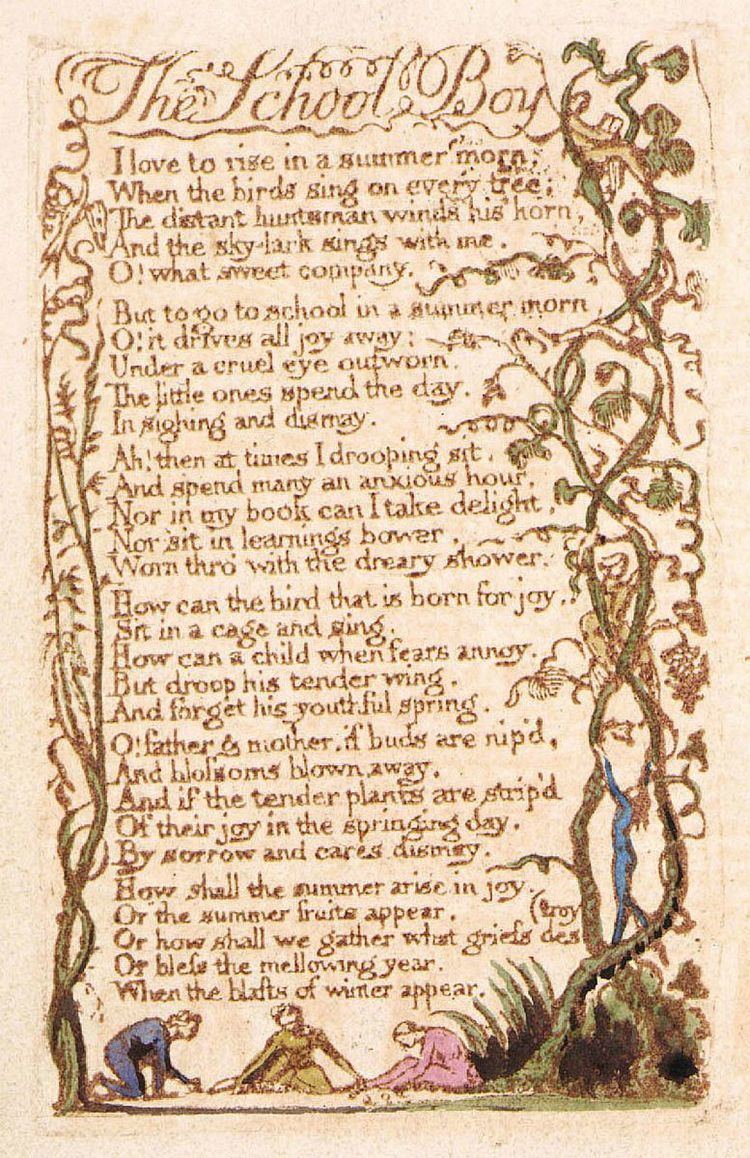 | ||
"The School Boy" is a 1789 poem by William Blake and published as a part of his poetry collection entitled "Songs of Innocence." These poems were later added with Blake's "Songs of Experience" to create the entire collection entitled "Songs of Innocence and of Experience Shewing the Two Contrary States of the Human Soul." This collection included poems such as "The Tyger," "The Little Boy Lost," "Infant Joy," and "The Shepherd (Blake)." These poems are illustrated with colorful artwork created by Blake first in 1789. The first printing in 1789 consisted of sixteen copies. None of the copies of Songs of Innocence are exactly alike as some of them are incomplete or were colored in posthumously "in imitation of" other copies.
Contents
"The School Boy" is a poem written in the pastoral tradition that focuses on the downsides of formal learning. It considers how going to school on a summer day "drives all joy away". The boy in this poem is more interested in escaping his classroom than he is with anything his teacher is trying to teach. In lines 16-20, a child in school is compared to a bird in a cage. Meaning something that was born to be free and in nature, is instead trapped inside and made to be obedient.
What does each verse mean?
The first verse describes the delight of waking up to the birds singing and what a marvellous way this is to start the day.
The next verse, however, contrasts with verse one by describing how distraught the schoolboy is to be at school, and how the thought of this halts his happiness immediately.
Verse three describes school, how when home-schooled you can sit happily and read. At school, there is no freedom; you will learn what you are told to learn, nothing more, nothing less. School cannot delight him.
Verse four compares a boy at school to a bird in a cage: his potential is restrained.
The fifth verse shows how people are dismayed at school and how students are stripped of their joy.
The final verse describes how school can never be fun, but it is like a cold winter's day blasting through the warm summer.
Illustration and form
The illustration for this poem predominantly features elements of nature, which is reflected in the poem's content. At the bottom of the print, there are three human figures sitting down examining either the ground or something upon the ground. This indicates an interest in nature and of what it is compiled.
Around the border of the print is a weaving of intertwined vines. Within these vines are foliage such as leaves and flowers-nature within nature. There is also a human figure perched near the base of the vines with her arms extended, reaching up into the climbing flora. Further up the vines, there are two human figures sitting in the crook of two separate vines, each one is reading. This could indicate that the farther one travels into nature, the more one will learn. This, based on Blake's emphasis on a "Natural" education.
Also among the leaves and fruit of the vines, on the left of the print is a bird about to take flight. "Both victory and liberty [...] are associated with bird wings." Birds can also symbolize knowledge and nature. The presence of the bird, further indicated the freedom and learning that can come from education from nature rather than the formal classroom.
Arranged in six stanzas with five lines each, this poem follows a consistently patterned structure. It also contains a rhyme scheme of ababb.
Themes and critical analysis
This poem highlights Blake's affinity for alternative methods of education. Consistently repeated is the draining element of schoolroom education and how it causes students to contribute poor learning and retention for students. Blake instead promotes learning outside the classroom, specifically learning in nature where he believes spontaneous and natural creativity flourishes.
The analogy of the bird and the boy is also evidence of the recurring theme of nature within this poem. As a poet of Romanticism, Blake puts an emphasis on nature, the subjective self and on emotions. Within this poem, the allusions to nature are everywhere referencing things such as summer, wind, blossoms, rain showers, birds and spring. Blake equates the seasons of the Earth to the seasons of the boy's life. Blake also analogizes the boy with a caged bird unable to sing, to attain its free place in nature, just like the boy.
David Almond references "The School Boy" in his novel Skellig to validate his character, Mina's nonformal learning provided to her by her mother and supplemented heavily by Blake's materials. Sahm writes that, "Mina and her mother quote and reference Blake directly, and many of the characters share his interest in education, spirituality, and imagination. But more than merely quoting Blake’s words, the characters in Skellig live and exemplify one of his primary ideas: that of contraries.". Namely in Skellig, Almond uses "The Schoolboy" as primary evidence for his character, Mina's non-traditional education. Which ties in with the text of the poem which continually brings up how being in a traditional school setting is draining, and will make a boy "forget his youthful spring."
